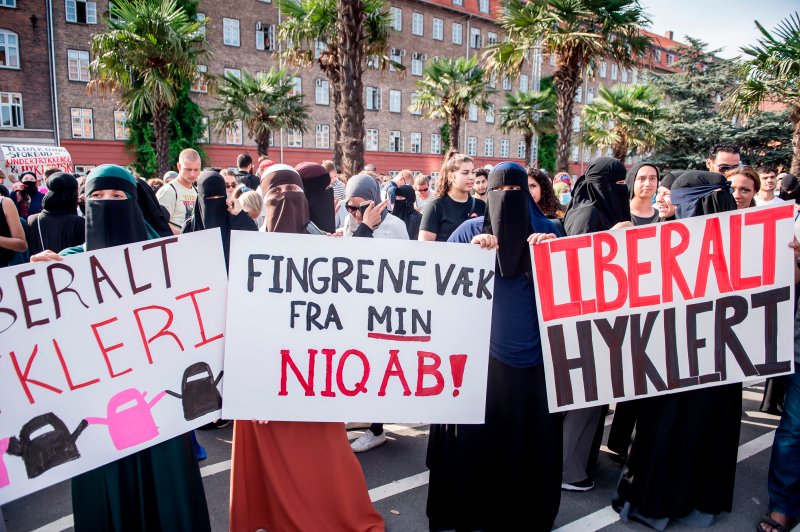We women will decide what to wear
 Monday, July 19, 2021 at 06:52AM
Monday, July 19, 2021 at 06:52AM 
August 1, 2018, Copenhagen, Denmark. Mads Claus Rasmussen—AFP/Getty Images
(Article riginally published in Danish in Politiken, July 19, 2021)
On 15 July, the European Court of Justice - the EU's highest court - ruled that EU-based companies are free to ban visible religious symbols and that EU countries can choose to enforce such bans as they see fit. Although the ruling is worded to apply to all religious symbols and dress, experience says it will be applied almost exclusively to Muslim women who want to cover their hair or face or both.
The ban on the wearing of religious symbols raises many red flags for those who care about human rights.
And they should be of great concern in Europe, where more and more countries are restricting the use of headscarves or face veils in public. A 2018 report commissioned by Open Society Foundations found that only six countries in the EU - Croatia, Cyprus, Greece, Poland, Portugal and Romania - have not banned headscarves or face veils in some form or discussed a proposal to do so.
France was the first European country to adopt a general ban on covering one's face in public; the ban came into force in 2011. Denmark joined this dubious European trend in 2018. While both the Danish and French laws are written in a neutral way - they prohibit all persons from covering their face in public unless for specific purposes - the debate and stated motivation for the law was, at least in part, to "liberate" women from the "imposition of the veil". It should be added that although some laws 'only' prohibit face veils while allowing headscarves, the underlying motivation and trend is the same, as evidenced by Thursday's ruling. It is about gradually banning any visual expression of Islam in European countries.
The obsession with headscarves and face veils in the name of tolerance and non-discrimination is deeply misleading.
Firstly, clothing is generally a matter of freedom of expression. If a government imposes its view on how everyone should dress, it interferes with our ability to express ourselves freely, whether this is expressed as a clothing ban ('you must not wear a headscarf') or a requirement ('you must').
Secondly, it also affects our human right to freely express our beliefs when the imposed or prohibited clothing is predominantly linked to a particular religion. UN experts on freedom of religion have repeatedly made it clear that although state religions (such as the Danish one) are allowed, majority religions cannot be imposed on those who do not share that faith. Banning clothing that has a particular meaning in a particular religion is ostensibly neutral, but it is a poor veil for overt discriminatory intent. It may be that everyone in Denmark is forbidden to cover their face in public, but only those for whom covering their face is an expression of their faith suffer from this.
Third, the alleged 'liberation intention' is particularly problematic in overcoming harmful stereotypes and discrimination. When a government says or implies through its policies and actions that most Muslim women who wear headscarves do so because they are 'oppressed', far from liberating each Muslim woman, it deprives her of any autonomy in terms of freedom of expression and freedom of religion. Moreover, if a government maintains the stereotype that all Muslim women are submissive and oppressed, this is not very conducive to integration and understanding in society at large. Moreover, it only affects women and therefore actively contributes to any gender discrimination that may already exist.
From a human rights perspective, all governments have a duty to combat gender inequality across the board. Where gender inequality is reinforced by social norms and religious arguments - whether based on Islam, Christianity, Judaism or another religion - the state must ensure access to information and resources to prevent discrimination and provide redress in cases of abuse.
Indeed, the most disturbing aspect of the headscarf ban is that misplaced 'liberation' policies can make very real problems invisible. Recent studies by Amnesty International show that the Covid-19 pandemic has exacerbated already widespread violence against women in Europe. The victims of this violence are not all Muslims, and certainly not all of them cover their hair. These women need urgent state protection, but instead governments across Europe seem to prefer to spread myths and prejudice.
Thursday's ruling by the European Court of Justice on headscarves will make it easier for governments and businesses across Europe to continue this trend of divesting from real problems, such as gender-based and anti-Muslim violence, while claiming neutrality and tolerance.
But make no mistake, there is nothing neutral about it.
The continued obsession with headscarves and other symbols of Islam in Europe is inherently based on prejudice and will fuel further violence and abuse. The Danish government must take urgent steps to prevent and eliminate all forms of discrimination in the workplace, including discrimination based on religious stereotypes.







